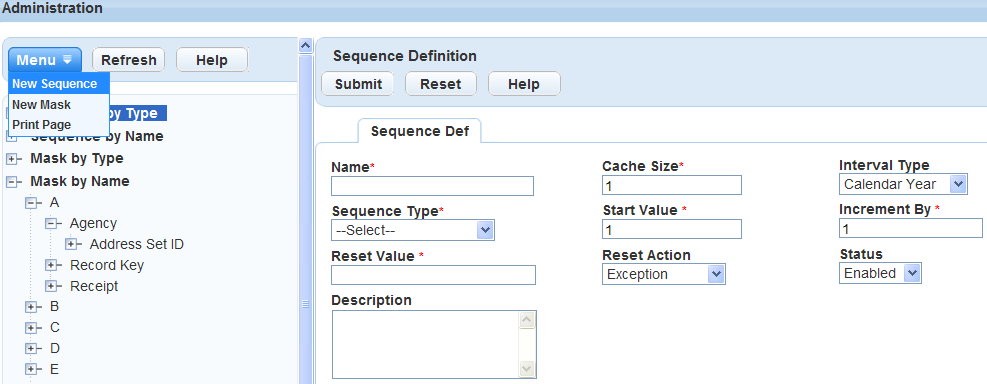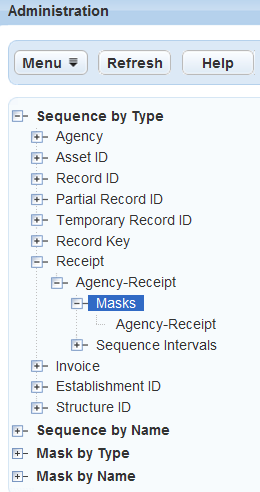Setting Up Number Sequences and Masks
This section explains how to define a Sequence Definition. We provide instructions for Mask Definitions and provide examples for sequence numbering and formatted output of a sequence (how the result displays to the user).
Civic Platform divides all Sequence Definitions into three elements, the Sequence Definition, the Mask Definition, and the Sequence Intervals.
You must define the Sequence Definition before you can assign it to a Mask Definition.
Civic Platform organizes sequence types into several categories: Agency, Asset ID, Record ID, Record Key, Partial Record ID, Temporary Record ID, and Receipt. For each category there is a pre-defined setting that you can use without further configuration. It is ready to use immediately.
You can refer to Table 1. This table lists each default sequence type, mask name, sequence definition name, and a description of the default sequence types.
To create or modify a sequence
Access the Sequence Definition portlet (Navigating to the Setup).
To define a number sequence, do one of the following:
Create a new sequence for the item by right-clicking it from the navigation tree, then select New Sequence. You can also click the Menu button and select New Sequence from the drop-down list.
The sequence Name displays in the Sequence Definition portlet to the right.

Civic Platform organizes the items you can apply numbering to into several categories: Agency, Asset ID, Record ID, Partial Record ID, Temporary Record ID, Record Key, and Receipt. Each category has a Default numbering definition that is ready to use immediately, with no configuration. To review the pre-defined or Default settings refer to Table 1.
Sequence by Type organizes sequence definitions based on the sequence type: Agency, Asset ID, Record Id, Partial Record ID, Temporary Record Id, Record Key, and Receipt.
Sequence by Name lists the definitions based on the starting letter of the sequence definition name, and then by the sequence type.
Mask by Type organizes mask definitions based on the sequence type: Agency, Asset ID, Record Id, Partial Record ID, Temporary Record Id, Record Key, and Receipt.
Mask by Name lists the mask definitions based on the starting letter of the mask name, and then by the sequence type
To locate an existing item in the navigation tree, click the plus sign (+) to the left of the sequence or mask type to expand the list of items.

Complete or update the Sequence Definition fields. For field descriptions refer to Table 1.

Click Submit.
Civic Platform saves the Sequence Definition.
Click Refresh in the Navigation Tree to display the sequence you just created or updated. Now, you can apply a Mask Definition to the item.
Civic Platform loads the new sequence type you created or updated in the Navigation Tree.
In the tree, locate the new or updated sequence and select (+) Masks.
The Mask Definition portlet displays to the right.
Complete the Mask Definition fields. For field descriptions refer to Table 2.
Optionally, use the Validate button. It takes the Maximum and Minimum Length, Sequence Type, and Sequence Number Base and validates them against the mask Pattern using a sequence of 1 and today's date.

Click Submit to save the Mask Definition.
Civic Platform automatically manage the Sequence Interval.
Table 1. Sequence Definition Fields Cache Size (Required) Enter the value to reflect how many of the numbers you want the sequence to pull or reserve at a time. The default value is 1. We recommend you do not change this value. Description Text for describing the pattern or any other characteristics of this sequence definition. Maximum of 200 characters. Increment By (Required) Enter the number that specifies the increase using a positive integer. Civic Platform does not support negative integers. Interval Type Select the type of interval for this sequence. Options are None, Calendar Year, Calendar Month, Calendar Day, Fiscal Year, Fiscal Quarter, Fiscal Month. The sequence value restarts based upon the interval type. For example, selecting Calendar Year means the sequence number resets itself to the Starting Value at the start of every calendar year. Select None if you do not want the sequence number to reset itself based upon a date.
Name Enter a unique name for this sequence definition. It must be unique within the Sequence Type selected. Reset Action This field works in conjunction with the Reset Value. Reset Action tells the sequence generator what action to take if you exceed the Reset Value maximum. The default setting is Exception. You must configure Record Keys and Record IDs to throw an Exception. Note:You must configure all categories to throw an exception, except the Agency sequence type. You should only use the other one (Set to minimum) if duplicate sequence numbers are acceptable. Do not configure the Set to minimum option unless you are certain that duplicate numbers are not a problem.If you exceed the Reset Value maximum and an Exception error displays, this is a very serious matter. Contact Accela Customer Support to resolve the issue. You might need to change the format.
Civic Platform stores many of the sequence numbers in database columns whose values must be unique. If you choose the Set To Minimum option, the sequence number resets to the Start Value if you exceed the Reset Value.
Reset Value Enter the maximum value you want Civic Platform to generate from this sequence definition. When you exceed this maximum value the Reset Action triggers. Sequence Type Groups of related sequence definitions. The groups are: Asset ID, Invoice, Record ID, Partial Record ID, Temporary Record ID, Record Key, Receipt, and Agency. One exception to this grouping is the Agency type which groups all single definitions together. Each Sequence Type must have a unique Name. NOTE: When you create the Mask Definition for an item, first select the Sequence Type that is the same as the Sequence Definition. This filters the Sequence Definition Name drop-down, listing only the Sequence Definitions available for that Type. Then specify this Sequence Definition using the Table 2.
Start Value Minimum starting value for the sequence. Status Enabled means you can use this definition. Set to Disabled if you no longer need to use this sequence definition. You cannot delete a sequence definition Table 2. Mask Definition Fields Description Text for describing the pattern or any other characteristics of this mask. Maximum of 200 characters. Maximum Length Enter a numeric value that defines the total number of allowed characters for the item or for the formatted sequence output. For example, a receipt number, or a Record ID number. Agency can be different for a pre-defined mask. Minimum Length Enter the minimum number of characters for the formatted sequence output. Name The name that defines the sequence mask.Maximum of 200 characters. Pattern Mask pattern describes how Civic Platform formats the sequence output. You must consider several fields when creating a pattern: The Sequence Number Base field works with the pattern. To make the pattern human-readable apply Base10. To use a key or coded apply Base36. The Sequence Number Base (10 or 36) is in this part of the sequence output [$$SEQ$$].
The Reset Value and Interval Type in the Sequence Definition. See Recommended Patterns and Sequence Reset Values.
Include the date value in the pattern of the Interval Type to prevent duplication of numbers.
Sequence Def Name Select the sequence definition name for this mask to generate sequence numbers. You can only select a sequence definition from the drop-down list that is the same Sequence Type for the Mask Definition.You must define the Sequence Definition before you can assign it to a Mask Definition.
Sequence Number Base Use Base 10 for user readable numbers. Use Base 36 to display the sequence output [$$SEQ$$] using numbers and letters [0-9] and [A-Z]. See examples of mask patterns using Base 10 and Base 36 in Table 2
.Sequence Type Select the category of the sequence. For example, Record ID or Receipt. You cannot mix Mask Definitions and Sequence Definitions with different Sequence Types. You also cannot assign a Record Key Mask Definition in place of a Record ID definition Status Enabled means you can use this definition. Set to Disabled if you no longer need to use this mask definition. You cannot delete a mask definition.